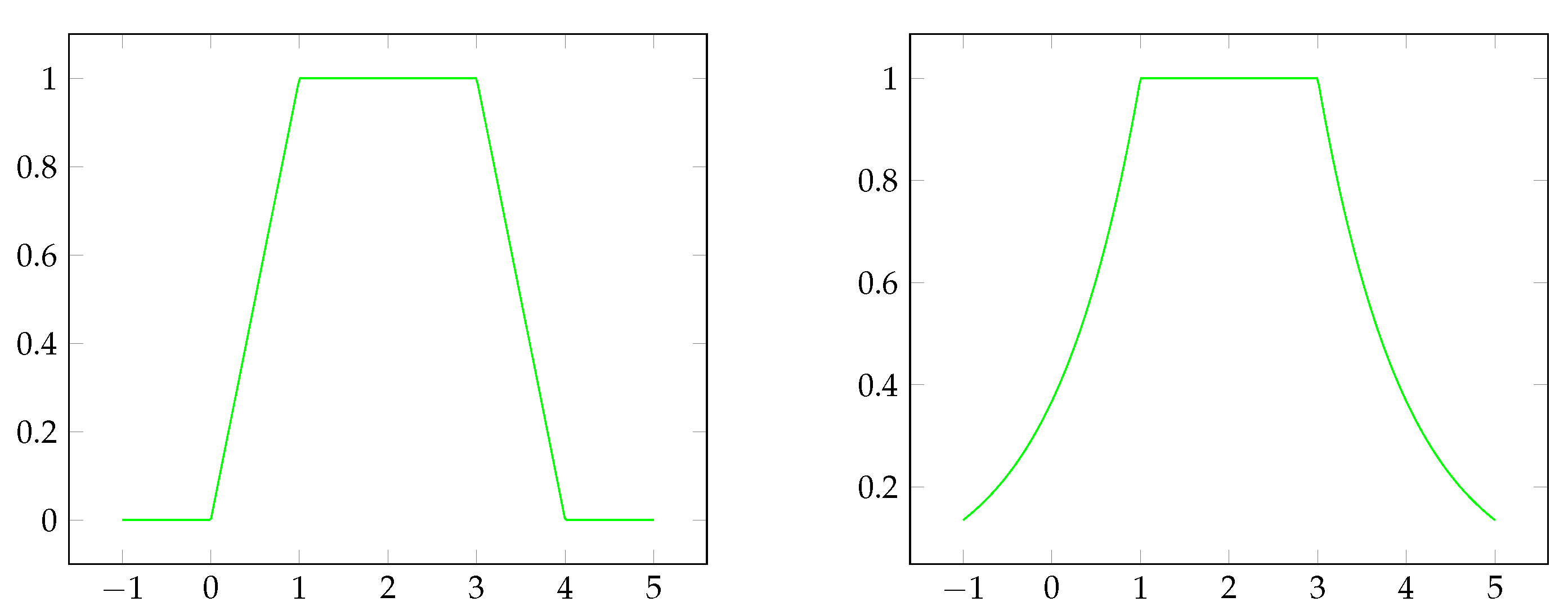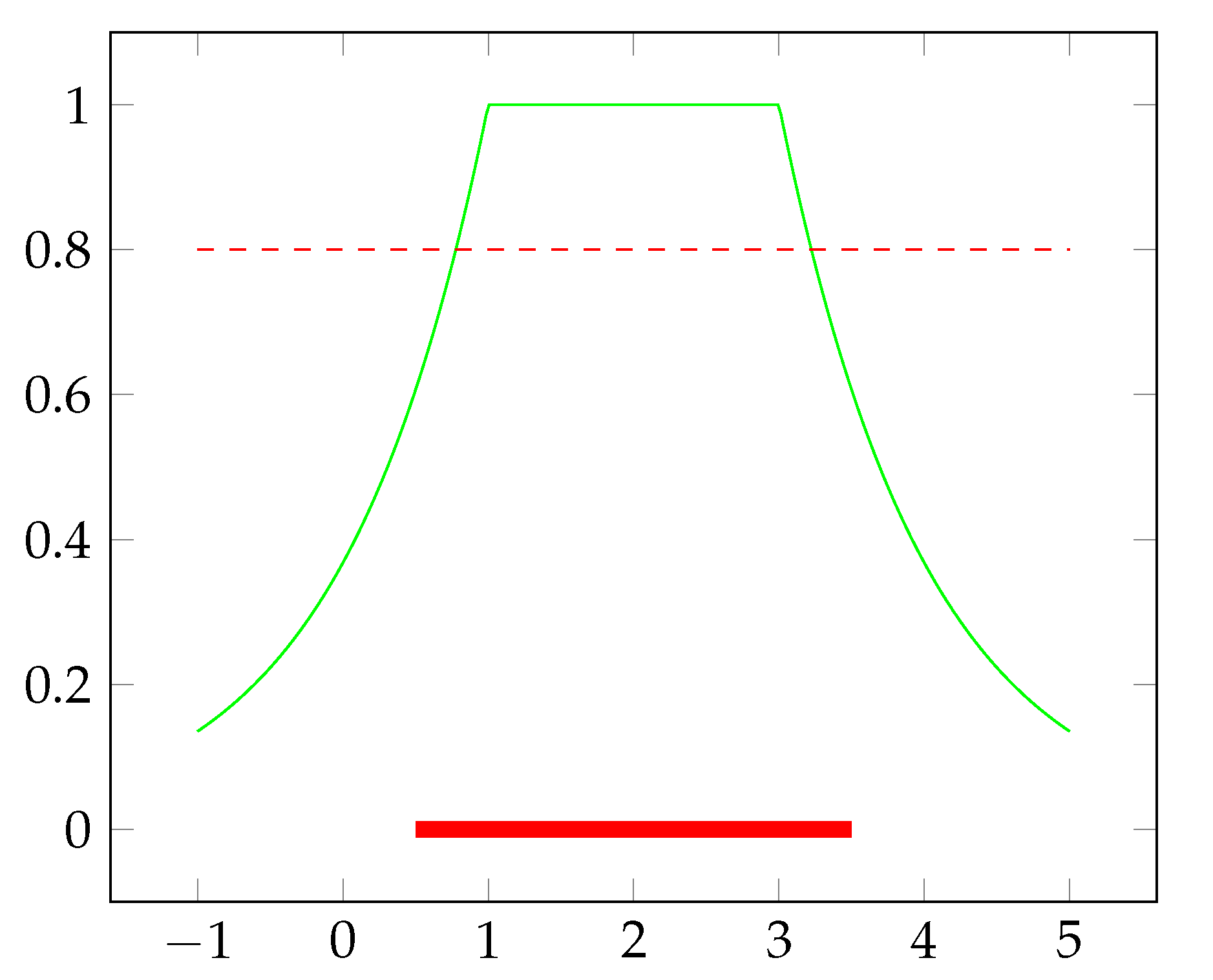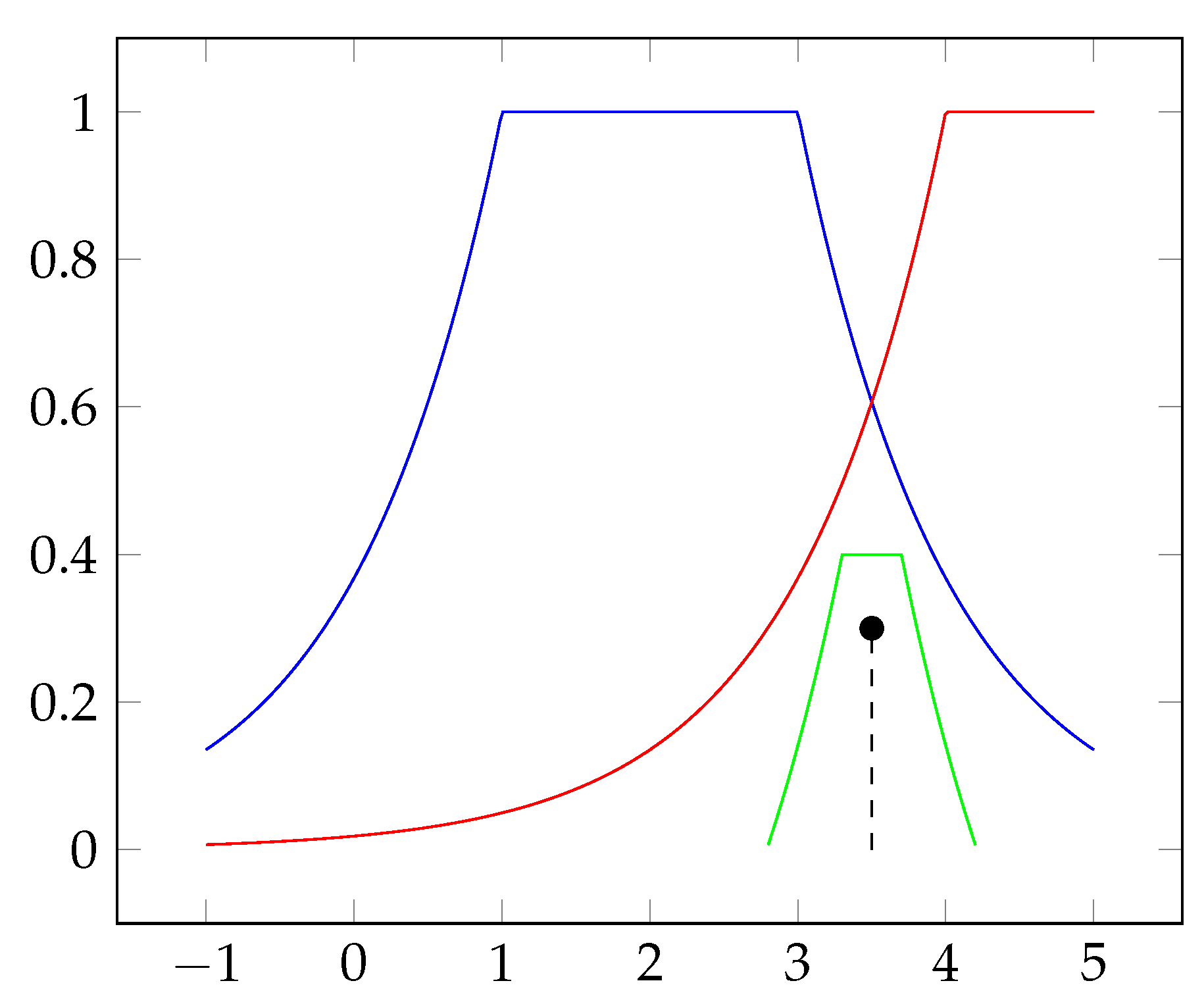Fuzzy Extension of Crisp Metric by Means of Fuzzy Equivalence Relation
Abstract
1. Introduction
Fuzzy Extension of an Ordinary Metric vs. Classical Fuzzy Metrics
2. Preliminaries
2.1. Triangular Norms
- (commutativity);
- (associativity);
- whenever (monotonicity);
- (a boundary condition).
- (minimum t-norm);
- (product t-norm);
- (ukasiewicz t-norm);
- (Hamacher t-norm).
2.2. Fuzzy Relations
- 1.
- reflexivity;
- 2.
- symmetry;
- 3.
- T-transitivity.
- 1.
- E-reflexivity;
- 2.
- T-transitivity;
- 3.
- T-E-antisymmetry.
- 1.
- L is a strongly linear T-E-order on S;
- 2.
- There exists a linear order ⪯ the relation E is compatible with, such that L can be represented as follows:
2.3. Fuzzy Metrics
- (KM0)
- ;
- (KM1)
- for all if and only if ;
- (KM2)
- ;
- (KM3)
- ;
- (KM4)
- is left-continuous.
- (GV0)
- ;
- (GV1)
- if and only if ;
- (GV2)
- ;
- (GV3)
- ;
- (GV4)
- is continuous.
- (GV3’)
- .
3. Fuzzy Equivalence Based Fuzzy Metrics
- If and , then ;
- If and , then , which contradicts ;
- If and , then and . Hence, taking into account the latest, and thus , which means ;
- If and , then the proof is similar to the previous case.
- in case T is the ukasiewicz t-norm;
- in case T is the product t-norm;
- in case T is the Hamaher t-norm.
4. Topological Issues of E-d-Metrics
4.1. Topologies Generated by E-d-Metrics
- If , then for and every , we also have two cases:
- (a)
- If , then . This means ;
- (b)
- If , then since . If , then obviously . Let us consider the case when ; we are going to prove that :because . Taking into account and condition (3) for E-d metric ,. Note that, in this case, can be taken as .
- If but , then there exists , such that because E is lower-semicontinuous . Let and let us consider a point .If , then obviously . Consider the case when ; we are going to prove that a level exists such that, if , then , which means :since . Taking into account that , we conclude that .Further, there exists such that , where and . Hence, .
4.2. Fuzzy Topologies Generated by E-d-Metrics
4.2.1. Some Notions on Fuzzy Topologies
- 1.
- τ contains and ;
- 2.
- τ is closed under finite meets, that is: for all ;
- 3.
- τ is closed under arbitrary joins, that is: for all .
- 1.
- For every fuzzy point on X, there exists such that ;
- 2.
- For every two and every there exists such that .
4.2.2. Fuzzy Topologies Generated by E-d-Metrics
5. Relations between Fuzzy Metrics and E-d-Metrics
- If then and for each .However, we could conclude that only if for all , which is equivalent to the (KM1) axiom;
- For sure, since metric d fulfils the symmetry condition, which is equivalent to (KM2) and (GV2) axioms;
- Let us prove that , which is equivalent to (KM2) and (GV2) axioms:If then and conditionfulfills immediately. Thus, we consider the case when . Let us consider four cases:
- (a)
- If and thenbecause of the condition (1);
- (b)
- If and then , which contradicts , or in other wordsfulfills immediately;
- (c)
- If and then = . If and then from the condition (3) we haveNow if but still we have:;
- (d)
- If and , then the proof is similar to the previous case.
- Continuity of M depends on continuity of E: if E is lower-semicontinuous then is left-continuous; if E is continuous then is continuous.
6. Conclusions
Author Contributions
Funding
Institutional Review Board Statement
Informed Consent Statement
Data Availability Statement
Acknowledgments
Conflicts of Interest
References
- Zadeh, L.A. Fuzzy Sets. Inf. Control 1965, 8, 338–353. [Google Scholar] [CrossRef]
- Chang, C.L. Fuzzy topological spaces. J. Math. Anal. Appl. 1968, 24, 182–190. [Google Scholar] [CrossRef]
- Rosendeld, A. Fuzzy groups. J. Math. Anal. Appl. 1971, 35, 512–517. [Google Scholar] [CrossRef]
- Kramosil, I.; Michalek, J. Fuzzy metrics and statistical metric spaces. Kybernetika 1975, 11, 336–344. [Google Scholar]
- George, A.; Veeramani, P. On some results in fuzzy metric spaces. Fuzzy Sets Syst. 1994, 64, 395–399. [Google Scholar] [CrossRef]
- Deng, Z. Fuzzy pseudo-metric spaces. J. Math. Anal. Appl. 1982, 86, 74–95. [Google Scholar] [CrossRef]
- Kaleva, O.; Seikkala, S. On fuzzy metric spaces. Fuzzy Sets Syst. 1984, 12, 215–229. [Google Scholar] [CrossRef]
- Ying, M. A new approach for fuzzy topology (I). Fuzzy Sets Syst. 1991, 39, 303–321. [Google Scholar] [CrossRef]
- Ying, M. A new approach for fuzzy topology (II). Fuzzy Sets Syst. 1992, 47, 221–232. [Google Scholar] [CrossRef]
- Klawonn, F.; Castro, J.L. Similarity in fuzzy reasoning. Mathw. Soft Comput. 1995, 2, 197–228. [Google Scholar]
- Klawonn, F. Fuzzy points, fuzzy relations and fuzzy functions. In Discovering the World with Fuzzy Logic; Novak, V., Perfilieva, I., Eds.; Springer: Berlin/Heidelberg, Germany, 2000; pp. 431–453. [Google Scholar]
- Klawonn, F.; Kruse, R. Equality relations as a basis for fuzzy control. Fuzzy Sets Syst. 1993, 54, 147–156. [Google Scholar] [CrossRef]
- Holčapek, M.; Štěpnička, M. MI-algebras: A new framework for arithmetics of (extensional) fuzzy numbers. Fuzzy Sets Syst. 2014, 257, 102–131. [Google Scholar] [CrossRef]
- Grabiec, M. Fixed points in fuzzy metric spaces. Fuzzy Sets Syst. 1988, 27, 385–389. [Google Scholar] [CrossRef]
- George, A.; Veeramani, P. Some theorems in fuzzy metric spaces. J. Fuzzy Math. 1995, 3, 933–940. [Google Scholar]
- George, A.; Veeramani, P. On some results of analysis for fuzzy metric spaces. Fuzzy Sets Syst. 1997, 90, 365–368. [Google Scholar] [CrossRef]
- Gregori, V.; Miñana, J.-J. On fuzzy ψ-contractive sequences and fixed point theorems. Fuzzy Sets Syst. 2016, 300, 93–101. [Google Scholar] [CrossRef]
- Gregori, V.; Miñana, J.-J.; Morillas, S.; Sapena, A. Cauchyness and convergence in fuzzy metric spaces. RACSAM 2017, 111, 25–37. [Google Scholar] [CrossRef]
- Gregori, V.; Miñana, J.-J.; Morillas, S.; Sapena, A. On Principal Fuzzy Metric Spaces. Mathematics 2022, 10, 2860. [Google Scholar] [CrossRef]
- Gregori, V.; Romaguera, S. Some properties of fuzzy metric spaces. Fuzzy Sets Syst. 2000, 115, 485–489. [Google Scholar] [CrossRef]
- Gregori, V.; Romaguera, S. On completion of fuzzy metric spaces. Fuzzy Sets Syst. 2002, 130, 399–404. [Google Scholar] [CrossRef]
- Gregori, V.; Romaguera, S. Characterizing completable fuzzy metric spaces. Fuzzy Sets Syst. 2004, 144, 411–420. [Google Scholar] [CrossRef]
- Gregori, V.; Romaguera, S. Fuzzy quasi-metric-spaces. Appl. Gen. Topol. 2004, 5, 129–136. [Google Scholar] [CrossRef]
- Gutiérrez-García, J.; Rodríguez-López, J.; Romaguera, S. On fuzzy uniformities induced by a fuzzy metric space. Fuzzy Sets Syst. 2018, 330, 52–78. [Google Scholar] [CrossRef]
- Mihet, D. On fuzzy contractive mappings in Fuzzy metric spaces. J. Fuzzy Sets Syst. 2007, 158, 915–921. [Google Scholar] [CrossRef]
- Romaguera, S.; Tirado, P. Characterizing complete fuzzy metric spaces via fixed point results. Mathematics 2020, 8, 273. [Google Scholar] [CrossRef]
- Camarena, J.G.; Gregori, V.; Morillas, S.; Sapena, A. Fast detection and removal of impulsive noise using peer groups and fuzzy metrics. J. Vis. Commun. Image Represent. 2008, 19, 20–29. [Google Scholar] [CrossRef]
- Morillas, S.; Gregori, V.; Peris-Fajarnés, G.; Latorre, P. A fast impulsive noise color image filtering using fuzzy metrics. Real-Time Imaging 2005, 11, 417–428. [Google Scholar] [CrossRef]
- Morillas, S.; Gregori, V.; Peris-Fajarnés, G.; Sapena, A. Local self-adaptative fuzzy filter for impulsive noise removal in color image. Signal Process. 2008, 8, 330–398. [Google Scholar]
- Grigorenko, O. Fuzzy Metrics for Solving MODM Problems. In Atlantis Studies in Uncertainty Modelling, Joint Proceedings of the 19th World Congress of the International Fuzzy Systems Association (IFSA), the 12th Conference of the European Society for Fuzzy Logic and Technology (EUSFLAT), and the 11th International Summer School on Aggregation Operators (AGOP), Bratislava, Slovakia, 19–24 September 2021. [Google Scholar]
- Klement, E.P.; Mesiar, R.; Pap, E. Triangular Norms; Kluwer Academic Publishers: Dodrecht, The Netherlands, 2000. [Google Scholar]
- Zadeh, L.A. Similarity relations and fuzzy orderings. Inform. Sci. 1971, 3, 177–200. [Google Scholar] [CrossRef]
- De Baets, B.; Mesiar, R. Pseudo-metrics and T-quivalences. J. Fuzzy Math. 1997, 5, 471–481. [Google Scholar]
- Bodenhofer, U. A similarity-based generalization of fuzzy orderings preserving the classical axioms. Internat. J. Uncertain. Fuzziness-Knowl.-Based Syst. 2000, 8, 593–610. [Google Scholar] [CrossRef]
- Höhle, U. M-valued sets and sheaves over integral commutative clmonoids. In Applications of Category Theory to Fuzzy Subsets; Rodabaugh, S.E., Klement, E.P., Höhle, U., Eds.; Kluwer: Dodrecht, The Netherlands; Boston, MA, USA, 1992; pp. 33–72. [Google Scholar]
- Lowen, R. Fuzzy topological spaces and fuzzy compactness. J. Math. Anal Appl. 1976, 56, 621–633. [Google Scholar] [CrossRef]
- Liu, Y.-M.; Luo, M.-K. Fuzzy Topology; World Scientific: Singapore, 1997. [Google Scholar]
- Wong, C.K. Fuzzy points and local properties of fuzzy topology. J. Math. Anal. Appl. 1974, 46, 316–328. [Google Scholar] [CrossRef]



Publisher’s Note: MDPI stays neutral with regard to jurisdictional claims in published maps and institutional affiliations. |
© 2022 by the authors. Licensee MDPI, Basel, Switzerland. This article is an open access article distributed under the terms and conditions of the Creative Commons Attribution (CC BY) license (https://creativecommons.org/licenses/by/4.0/).
Share and Cite
Grigorenko, O.; Šostak, A. Fuzzy Extension of Crisp Metric by Means of Fuzzy Equivalence Relation. Mathematics 2022, 10, 4648. https://doi.org/10.3390/math10244648
Grigorenko O, Šostak A. Fuzzy Extension of Crisp Metric by Means of Fuzzy Equivalence Relation. Mathematics. 2022; 10(24):4648. https://doi.org/10.3390/math10244648
Chicago/Turabian StyleGrigorenko, Olga, and Alexander Šostak. 2022. "Fuzzy Extension of Crisp Metric by Means of Fuzzy Equivalence Relation" Mathematics 10, no. 24: 4648. https://doi.org/10.3390/math10244648
APA StyleGrigorenko, O., & Šostak, A. (2022). Fuzzy Extension of Crisp Metric by Means of Fuzzy Equivalence Relation. Mathematics, 10(24), 4648. https://doi.org/10.3390/math10244648






